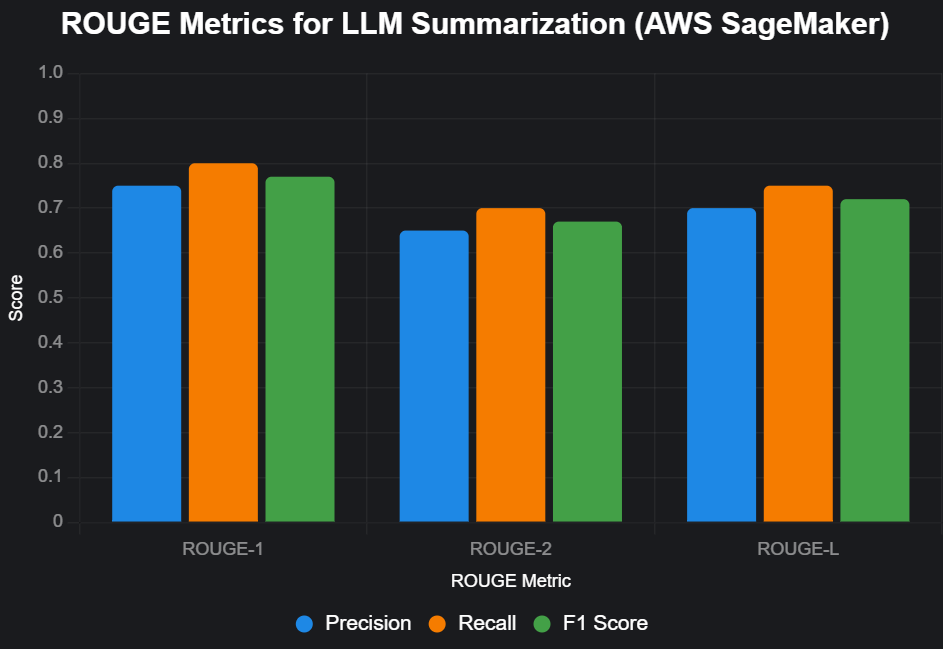Last updated on July 8, 2025
Recall-Oriented Understudy for Gisting Evaluation (ROUGE) Cheat Sheet
-
ROUGE is a family of metrics designed to assess the similarity between machine-generated text (candidate) and human-written reference text (ground truth) in NLP tasks like text summarization and machine translation.
-
Measures how well generated text captures key information and structure from reference text, emphasizing recall (proportion of relevant information preserved).
-
Score Range: 0 to 1, where higher scores indicate greater similarity between candidate and reference texts.
-
Key Use Cases:
-
Evaluating text summarization systems.
-
Assessing machine translation quality.
-
Analyzing content accuracy in generated text.
-
Types of ROUGE Metrics
-
ROUGE-N:
-
Measures the overlap of n-grams (sequences of n words) between candidate and reference texts.
-
Variants:
-
ROUGE-1: Unigram (single word) overlap.
-
ROUGE-2: Bigram (two consecutive words) overlap.
-
ROUGE-3, ROUGE-4, ROUGE-5: Trigram, 4-gram, and 5-gram overlaps, respectively.
-
-
Useful for assessing word-level and phrase-level similarity.
-
-
ROUGE-L:
-
Based on the Longest Common Subsequence (LCS) between candidate and reference texts.
-
Captures sentence-level structure and fluency by focusing on the longest in-sequence (but not necessarily consecutive) word matches.
-
Does not require consecutive matches, making it suitable for evaluating reordered but coherent text.
-
-
ROUGE-L-SUM:
-
Specifically designed for text summarization tasks.
-
Measures the LCS at the summary level, considering the order of words to evaluate how well the summary preserves the reference’s structure.
-
-
Other Variants (Less Common):
-
ROUGE-W: Weighted LCS, favoring longer consecutive matches.
-
ROUGE-S: Skip-bigram co-occurrence, allowing gaps between words in matching pairs.
-
ROUGE-SU: Combines skip-bigrams and unigrams for a more comprehensive evaluation.
-
Key Evaluation Measures
-
Recall: Proportion of n-grams (or LCS) from the reference text that appear in the candidate text.
-
Formula (ROUGE-N): (Number of overlapping n-grams) / (Total n-grams in reference)
-
Formula (ROUGE-L): (Length of LCS) / (Total words in reference)
-
-
Precision: Proportion of n-grams (or LCS) in the candidate text that appear in the reference text.
-
Formula (ROUGE-N): (Number of overlapping n-grams) / (Total n-grams in candidate)
-
Formula (ROUGE-L): (Length of LCS) / (Total words in candidate)
-
-
F1 Score: Harmonic mean of precision and recall, balancing both measures.
-
Formula: 2 * (Precision * Recall) / (Precision + Recall)
-
-
Interpretation:
-
High recall: Candidate captures most of the reference’s content.
-
High precision: Candidate includes few irrelevant elements.
-
High F1: Good balance of recall and precision, indicating overall similarity.
-
Advantages of ROUGE
-
Recall-Oriented: Prioritizes capturing all critical information from the reference, crucial for summarization tasks.
-
Flexible: Multiple variants (ROUGE-N, ROUGE-L, etc.) allow evaluation at different granularity levels (word, phrase, sentence).
-
Language-Independent: Works with any language, as it relies on syntactic overlaps.
-
Fast and Scalable: Computationally inexpensive, suitable for large-scale evaluations in AWS environments.
-
Correlates with Human Judgment: ROUGE scores often align with human assessments of content coverage and fluency.
Limitations
-
Syntactic Focus: Relies on word/phrase overlaps, missing semantic similarities (e.g., synonyms or paraphrases).
-
Reference Dependency: Requires high-quality human references, which may not always be available.
-
Context Insensitivity: Does not account for the broader context or domain of the text (e.g., legal vs. casual).
-
Preprocessing Sensitivity: Results can vary based on text normalization (e.g., case sensitivity, stop word removal).
-
Not Comprehensive Alone: Should be used alongside other metrics (e.g., BLEU, BERTScore) for a holistic evaluation.
Best Practices in AWS
-
Choose the Right ROUGE Variant:
-
Use ROUGE-1 for keyword presence in domains like legal or medical texts.
-
Use ROUGE-2 or higher for phrase-level accuracy.
-
Use ROUGE-L for sentence-level coherence in news or narrative summaries.
-
Use ROUGE-L-SUM for evaluating multi-sentence summaries.
-
-
Normalize Text: Ensure consistent preprocessing (e.g., lowercasing, removing punctuation) for candidate and reference texts to avoid skewed scores.
-
Set Thresholds: Adjust precision, recall, and F1 thresholds based on task requirements (e.g., higher recall for critical content preservation).
-
Combine Metrics: Use ROUGE with perplexity, BLEU, or human evaluations to capture fluency, precision, and ethical considerations (e.g., toxicity).
-
Leverage SageMaker:
-
Integrate ROUGE evaluations into SageMaker workflows using MLflow or rouge-score Python libraries.
-
Automate evaluations post-fine-tuning to streamline model validation.
-

















